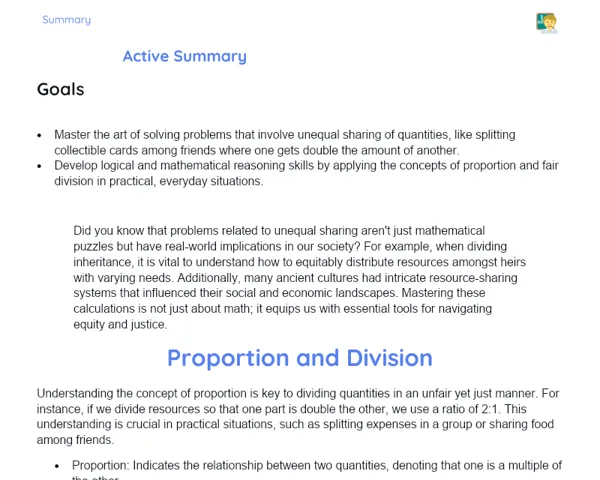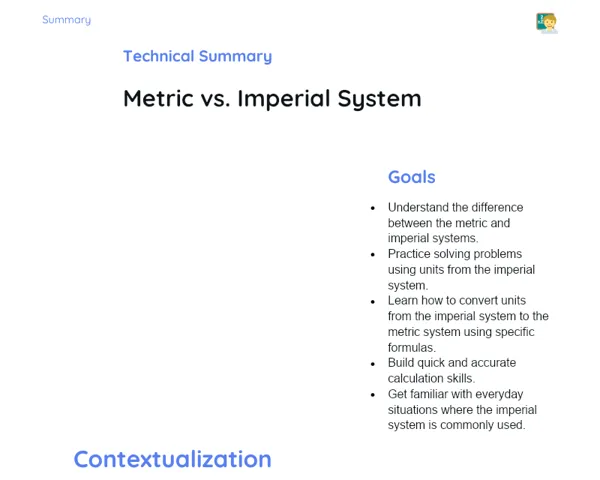Socioemotional Summary Conclusion
Goals
1. Grasp the formula of the Law of Cosines and how it helps us solve triangles. 🌟
2. Build the skill to identify and calculate the sides and angles of a triangle using the Law of Cosines. 🔍
Contextualization
Did you know that the Law of Cosines is a vital tool for navigators and engineers across our diverse land? 🚀 Picture calculating the exact distance between two towns on a map or determining the ideal slope of a ramp for accessibility! Mathematics is woven into the fabric of our daily lives, and mastering the Law of Cosines can empower us to tackle real-world problems with confidence and accuracy. Let's explore the mysteries of this powerful formula together and see how it can elevate our geometric understanding into practical skills! 🔧🌐
Exercising Your Knowledge
Definition of the Law of Cosines
The Law of Cosines is a formula that connects the sides of a triangle to the cosine of one of its angles. It extends the Pythagorean Theorem beyond right-angled triangles. The formula is represented as: a² = b² + c² - 2bc cos(α), where 'a', 'b', and 'c' are the sides of the triangle, and 'α' is the angle opposite side 'a'.
-
Formula: a² = b² + c² - 2bc cos(α).
-
An extension of the Pythagorean Theorem for triangles that are not right-angled.
-
Useful for calculating an unknown side or angle in any triangle.
Utility of the Law of Cosines
The Law of Cosines comes in handy for solving triangles when you know two sides and the angle between them, or all three sides of the triangle. Its applications stretch across diverse fields such as navigation, engineering, and astronomy.
-
Applications include navigation, engineering, astronomy, and construction.
-
Aids in solving practical problems like calculating distances and slopes.
-
Enhances problem-solving skills and critical thinking.
Practical Examples of the Law of Cosines
To gain a better grasp of the Law of Cosines, let’s explore two practical examples together. In the first, we’ll use the law to find the length of an unknown side of a triangle given two sides and the angle between them. In the second, we’ll determine an angle when all three sides of the triangle are known.
-
Example 1: Given b = 7 cm, c = 10 cm, and α = 60º, calculate side 'a'.
-
Example 2: Given a = 8 cm, b = 6 cm, and c = 5 cm, calculate angle 'α'.
-
Utilizes the inverse cosine function (arccos) to find the angle.
Key Terms
-
Law of Cosines: A formula linking the sides of a triangle to the cosine of an angle.
-
Triangle: A geometric figure formed by three sides and three angles.
-
Cosine: A trigonometric function relating the measure of an angle to the sides of a triangle.
For Reflection
-
How did you manage any frustration or anxiety while trying to solve problems using the Law of Cosines? What emotional strategies did you adopt to regain focus?
-
In what ways do you believe mastering the Law of Cosines can enhance your problem-solving abilities in other areas of your life?
-
How did collaborating with your peers during the activity contribute to your learning experience? Did you feel more confident and motivated working as part of a team?
Important Conclusions
-
The Law of Cosines serves as a robust tool for solving triangles when we know two sides and the angle between them, or all three sides.
-
Beyond understanding the mathematical formula a² = b² + c² - 2bc cos(α), we also learned how to apply it in everyday situations.
-
Developing problem-solving abilities with the Law of Cosines prepares us for future challenges and sharpens our critical and analytical thinking skills.
-
Collaborating with others and being mindful of our emotions during learning helps us grow both academically and personally. 😊
Impacts on Society
Understanding the Law of Cosines has significant implications for our society. From navigation, where it's crucial for accurately measuring routes and distances across our vast country, to engineering, where it aids in the planning and construction of essential structures like bridges and buildings. Mathematical precision ensures safety and efficiency in key projects supporting our modern world. 🌍
On a more personal level, the ability to apply the Law of Cosines can boost our confidence in mathematics and complex problem-solving. This fosters a growth mindset and resilience, enabling us to face challenges with positivity and proactivity. Such confidence can enhance our performance in academics as well as our interpersonal relationships. 💪
Dealing with Emotions
To better manage emotions while studying the Law of Cosines, I suggest the following exercise based on the RULER method: take a moment to reflect on a situation where you experienced frustration or anxiety while solving a problem. Begin by recognizing and naming your emotion (such as frustration or anxiety). Next, explore the root cause of that emotion – was it the difficulty of the problem, the fear of making a mistake, or something else? Then, express that emotion, either by jotting it down or confiding in someone you trust. Finally, brainstorm strategies to regulate that emotion when it arises again – this might include deep breathing techniques, taking breaks to rejuvenate your mind, or seeking help from a classmate or teacher. 🧘♂️
Study Tips
-
Go over the practical examples of the Law of Cosines we discussed in class and try solving similar problems on your own. ✍️
-
Form study groups with your friends to discuss and tackle problems together. Sharing ideas is a great way to deepen understanding. 👥
-
Utilize online resources, such as tutorial videos and simulators, to visualize how the Law of Cosines is applied in various scenarios. 💻



